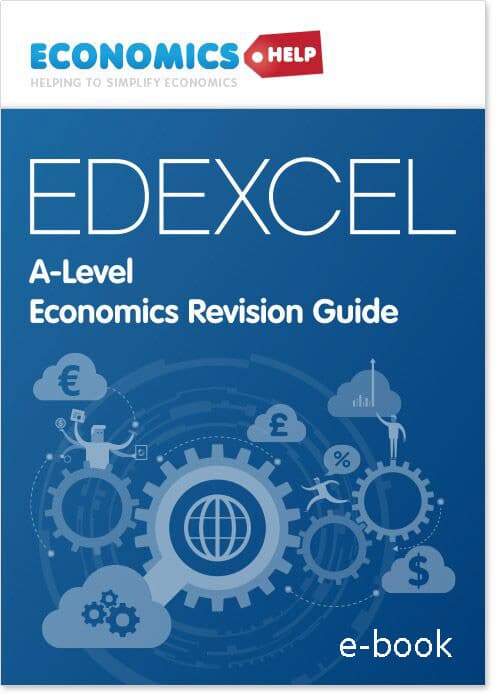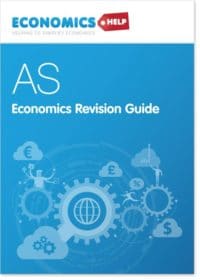Edexcel (A) Economics A-level revision guide
£8.95
- E-book (comes in pdf format shortly after purchase.)
- Specific Edexcel (A) – A-level economics revision guide (themes 1,2,3,4) – just £7.95
- Updated for the new Edexcel economics syllabus.
- Includes AS level guide.
- Trademark simplicity and clarity of presentation.
- Significantly expanded o the previous version, with not just required knowledge, but also examples of evaluation for each topic.
- For schools – See: Network License – A-level Edexcel Economics (£105.00)
- Coming Soon: Edexcel Economics (B)
Description
- E-book (comes as pdf)
- Content designed to help prepare for likely questions.
- AS section (units 1 and 2) – 108 pages, 20,000 words
- A2 micro / unit 3 – 61 pages, 15,000 words
- A2 macro / unit 4 – 63 pages, 17,000 words
- Total revision guide (AS+A2) – 232 pages, 52,000 words. All diagrams required
- Last updated June 2022.
Sample of A level economics revision guide
- View: Sample of AS Edexcel
- View: Sample of Theme 4
Related Products
- AS Edexcel economics revision guide – This includes just (unit 1 and 2) – £5.50
- A2 Edexcel economics revision guide – (units 3 and 4) – £5.50
Theme 1
- 1.1 Economics as a social science
- 1.2 Positive and normative economic statements
- 1.3 The economic problem
- 1.4 Production possibility frontiers
- 1.5 Specialisation and division of labour
- 1.6 Types of economies (free market, mixed, command)
How markets work
- 2.1 Rational decision making
- 2.2 Demand
- 2.3 Elasticity of demand / income / cross
- 2.4 Supply
- 2.5 Elasticity of supply
- 2.6 Price determination
- 2.7 Price mechanism
- 2.8 Consumer / producer surplus
- 2.9 Taxes and subsidies
- 2.10 Alternative views of consumer behaviour
Market failure
- 3.1 Types of market failure
- 3.2 Externalities
- 3.3 Public goods
- 3.4 Information gaps
Government intervention
- 4.1 Government intervention in markets
- 4.2 Government failure
Theme 2
Measures of economic performance
- 1.1 Economic growth
- 1.2 Inflation
- 1.3 Employment and unemployment
- 1.4 Balance of payments
Aggregate demand
- 2.1 Aggregate demand (AD)
- 2.2 Consumption (C)
- 2.3 Investment (I)
- 2.4 Government expenditure (G)
- 2.5 Net trade (X-M)
Aggregate supply
- 3.1 Aggregate supply AS
- 3.2 Short-run AS
- 3.3 Long-run AS
National income
- 4.1 National income
- 4.2 Injections and withdrawals
- 4.3 Equilibrium real national income
- 4.4 The multiplier
Economic growth
- 5.1 Causes of economic growth
- 5.2 Output gaps
- 5.3 Trade (business) cycle
- 5.3 Impact of economic growth
Macroeconomic objectives and policies
- 6.1 Possible macroeconomic objectives
- 6.2 Demand-side policies
- 6.3 Supply-side policies
- 6.4 Conflicts and trade-offs between objectives and policies.
Theme 3 – Business and labour markets
61 pages, 14,000 words
3.1 Business growth
- 1.1 Sizes and types of firms
- 1.2 Business growth
- 1.3 Demergers
3.2 Business objectives
- 2.1 Business objectives
3.3 Revenues, costs and profits
- 3.1 Revenue
- 3.2 Costs
- 3.3 Economies and diseconomies of scale
- 3.4 Normal profits, supernormal profits and losses
3.4 Market structures
- 4.1 Efficiency
- 4.2 Perfect competition
- 4.3 Monopolistic competition
- 4.4 Oligopoly
- 4.5 Monopoly
- 4.6 Monopsony
- 4.7 Contestability
3.5 Labour market
- 5.1 Demand for labour
- 5.2 Supply of labour
- 5.3 Wage determination in competitive and non-competitive markets.
3.6 Government intervention
- 6.1 Government intervention
- 6.2 The impact of government intervention
Theme 4 – A global perspective
63 pages, 17,000 words
4.1 International economics
- 1.1 Globalisation
- 1.2 Specialisation and trade
- 1.3 Pattern of trade
- 1.4 Terms of trade
- 1.5 Trading blocs and the World Trade Organisation (WTO)
- 1.6 Restrictions on free trade
- 1.7 Balance of payments
- 1.8 Exchange rates
- 1.9 International competitiveness
4.2 Poverty and inequality
- 2.1 Absolute and relative poverty
- 2.2 Wealth and income inequality
4.3 Emerging and developing economies
- 3.1 Measures of development
- 3.2 Factors influencing growth and development
- 3.3 Strategies influencing growth and development
4.4 The financial sector
- 4.1 Role of financial markets
- 4.2 Market failure in the financial sector
- 4.3 Role of central banks
4.5 The role of the state in the macro-economy
- 5.1 Public expenditure
- 5.2 Taxation
- 5.3 Public sector finances
- 5.4 Macro-economic policies in a global context





